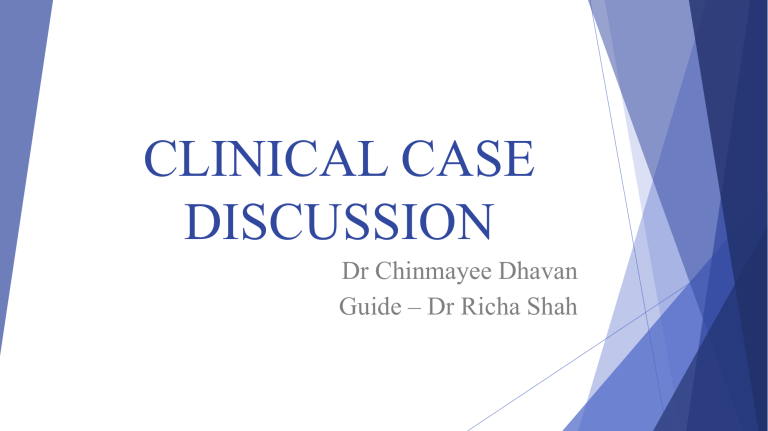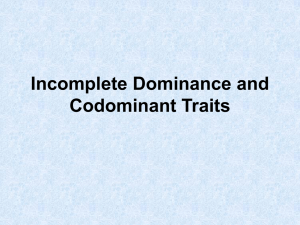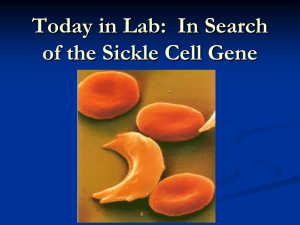
CLINICAL CASE DISCUSSION Dr Chinmayee Dhavan Guide – Dr Richa Shah Case 10 yr old male belonging to tribal regions of Maharashtra presents with history of jaundice. He gives history of painful ulcer over medial malleolus of leg since one month and history of recurrent pain in left hypochondrium. There is no history of passing high colored urine. O/E patient appears small for age Icterus +++ Pallor ++ + Ulcer over leg P/A- soft , liver and not palpable. CVS- Haemic murmur + Case 10 yr old male belonging to tribal regions of Maharashtra presents with history of jaundice. He gives history of painful ulcer over medial malleolus of leg since one month and history of recurrent pain in left hypochondrium. There is no history of passing high colored urine. O/E patient appears small for age Icterus +++ Pallor ++ + Ulcer over leg P/A- soft , liver and spleen not palpable. CVS- Haemic murmur + RS- NAD CNS- NAD Pallor Pale appearance of the skin and mucous membranes Causes: -anemia -Collapse and shock -myxodema -nephritis Icterus Yellowish discoloration of skin and mucous membranes. Causes Hemolytic anemias Gilbert syndrome Crigler-Nagler syndrome Viral infections – hepatits, herpes simplex etc Metabolic liver disease – Wilson disease , alpha 1 antitrypsin Biliary tract disorders- cholelithiasis , cholecystitis Vascular cause – Budd Chiari syndrome, veno- occlusive disease Left hypochondriac pain GERD Gastritis Pancreatitis Splenic infarct Splenic cyst Splenic abscess Positive findings in our patient history of jaundice recurrent pain in left hypochondrium small for age G/E- Icterus +++ Pallor ++ + Ulcer over leg S/E- CVS- Haemic murmur + How to investigate ? • CBC and Peripheral blood smear • Reticulocyte Count • LFT • ESR • Iron studies CBC RBC morphology HGB- 7g/dl Decreased HCT- 18% Decreased MCV- 85 fl Normal MCH- 30 pg Normal MCHC- Normal RDW- 20% INCREASED WBC -18,0000 Neutrophilic leucocytosis PLT- 500,000 mildly raised MORPHOLOGY-Anisopoikilocytosis ++ Normocytic Normochromic+ sickle cells +, boat shaped cells +, target cells + Polychromatophils + basophilic stippling+ , nucleated rbcs seen , howel jolly body noted Reticulocyte count – 8 % Increased Liver function test S.BILIRUBIN (TOTAL)-1.6ml/dl INCREASED S.UNCONJUGATED BILIRUBIN-1.8mg/dl INCREASED S.CONJUGATED BILIRUBIN-0.2 mg/dl (0-0.2) Iron studies – normal Esr – raised Sickling test Principle – sodium meta bisulphite reduces the oxygen tension and induces sickling of red blood cells Sample – fresh blood in any anticoagulant Method – 1 drop of reagent are added to 1 drop of anticoagulated blood on a slide. Cover glass is put on and sealed with petroleum jelly /paraffin wax mixture. In Hb SS, sickling occur immediately, while it may take 1 hour in Hb S trait. HAEMOGLOBIN SOLUBILITY TESTS Principle -Sickle cell haemoglobin is insoluble in the deoxygenated state in a high molarity phosphate buffer. The crystals that form refract light and cause the solution to be turbid.. The haemoglobin is added to a solution of sodium dithionite, a reducing agent, in phosphate buffer. If Hb-S is present, the solution becomes turbid. Whole blood may be used, but th·e addition of saponin, a lysing agent, then becomes necessary. Hemoglobin electrophoresis Initial screening test in the evaluation of haemoglobinopathies is electrophoresis at alkaline pH (8.5) using a Tris EDTA-borate buffer Various supporting media are used to achieve separation of haemoglobins such as filter paper, starch gel, or cellulose acetate membranes. Principle: The migration of molecules having a net charge in an electric field is known as electrophoresis. Different haemoglobins have different net charge because of variations in their structure. In an alkaline buffer solution, haemoglobins migrate from cathode (-) to anode (+) and various haemoglobins have different rates of migration due to differences in their charge. Identification of different haemoglobins is based on their relative positions on cellulose acetate strip Procedure 1. Red cells are haemolysed and a solution is prepared (haemolysate). 2. Haemolysate is applied near one end of cellulose acetate strip (point of origin). 3. Cellulose acetate strips are placed in the electrophoresis chamber containing Tris -EDTA-borate buffer with point of origin towards the cathode. 4. Electric current is applied till adequate separation is achieved. 5. The cellulose acetate strips are removed from the chamber, stained with a protein stain such as Ponceau S, and dried. Citrate Agar Electrophoresis at Acidic pH Citrate agar electrophoresis at acid pH provides separation of haemoglobins that have similar mobilities on cellulose acetate at alkaline pH. HbS can be distinguished from HbD and HbG, and HbC from HbE and HbO-Arab. However, haemoglobin variants D, E, G, Lepore, and H have migration identical to HbA. Hplc Screening test for (1) detection, identification, and quantification of haemoglobin variants (2) quantitation of HbA2 and HbF. Sickle cell anemia DIAGNOSIS Sickle cell anemia Sickle cell anemia Sickle cell disease is a common hereditary hemoglobinopathy caused by a point mutation in β-globin that promotes the polymerization of deoxygenated hemoglobin, leading to red cell distortion, hemolytic anemia, microvascular obstruction, and ischemic tissue damage. Hemoglobin Tetrameric structure is composed of 2 pairs of globin each with its own heme pair. Human haemoglobin exists in a number of types, which differ slightly in the structure of their globin moiety. Normal haemoglobin types In the embryo: Gower 1 (ζ2ε2) Gower 2 (α2ε2) Haemoglobin Portland (ζ2γ2 ) Haemoglobin Barts In the fetus: •Hemoglobin F (α2γ2) In adults: Hemoglobin A (α2β2) The most common with a normal amount over 95% Hemoglobin A2 (α2δ2) ‐ δ chain synthesis begins late in the third trimester and in adults, it has a normal range of 1.5‐3.5% • Hemoglobin F (α2γ2) ‐ In adults Hemoglobin F is restricted to a limited population of red cells • • Variant forms of hemoglobin which cause disease Hemoglobin S ‐β‐chain gene, causing a change in the properties of hemoglobin which results in sickling of red blood cells. Hemoglobin C‐ is formed by substitution of lysine for glutamic acid at position 6 of globin chain (β6 Glu→ Lys). Crystallisation of HbC increases rigidity of red cells, which are destroyed in spleen. This variant causes a mild chronic hemolytic anemia. Hemoglobin AS ‐ A heterozygous form causing Sickle cell trait with one adult gene and one sickle cell disease gene Hemoglobin SC disease ‐ Another heterozygous form with one sickle gene and another encoding Hemoglobin C. Variant forms of hemoglobin which cause disease Haemoglobin H (β4) ‐tetramer of β chains, which may be present in variants of α thalassemia Hb D-Punjab- a point mutation in the beta-globin gene (HBB) in the first base of the 121 codon (GAA→CAA) with the substitution of glutamine for glutamic acid (Glu>Gln) in the beta globin chain. Hemoglobin E (HbE) is an abnormal hemoglobin with a single point mutation in the β chain. At position 26 there is a change in the amino acid , from glutamic acid to lysine Types of sickle cell disease Sickle cell anemia: Homozygous state for HbS (βS- βS) Sickle cell trait : Heterozygous carrier state for HbS (βS -β) Double heterozygous for HbS- Sickle cell β thalassaemia Sickle cell hemogobin c disease Sickle cell hemoglobin d disease Pathology Autosomal recessive Defect in HBB gene , chromosome 11 , short arm results from inheritance of sickle-cell gene that codes for abnormal β globin chain. There is change of a single base A→ T in the sixth codon of β globin gene so that there is substitution of thymine for adenine. This in turn results in substitution of valine for glutamic acid at position 6 of β polypeptide chain (β6 Glu→Val ) Factors which influence sickling Intracellular concentration of HbS and of other haemoglobins Association with thalassaemias Interaction with other abnormal haemoglobins Mean corpuscular haemoglobin concentration (MCHC) Decreased oxygen tension Temperature Low pH Clinical features Growth and development: These are considerably impaired in children with sicklecell anaemia. Splenomegaly: seen in infants and young children and is caused by reticuloendothelial hyperplasia. In later life, spleen becomes small and fibrotic due to repeated splenic infarctions, and is not palpable. Spleen, however, remains palpable in adults in sickle-cell β thalassaemia. Vaso-occlusive crises Hematological crises Hematological crises Megaloblastic crisis: This results from folate deficiency that may develop during intercurrent illness or during pregnancy. Haemolytic (“Hyperhaemolytic”) crisis: Increased rate of red cell destruction over the chronic haemolytic state is called as haemolytic crisis. There is a sudden fall in haemoglobin concentration and levels of icterus and reticulocyte count increase. Haemolytic crisis is uncommon and coexistence of G6PD deficiency with superimposed oxidant stress may be responsible in some cases. Skin: Chronic leg ulcers are common around ankles on the medial aspect. They do not heal readily and have a tendency to recur. Proliferative retinopathy: Proliferative retinopathy due to retinal vascular occlusion is an important complication and is more common in patients with HbSC disease Arteriovenous communications and neovascularisation may lead to vitreous haemorrhage, detachment of retina, and visual loss Pregnancy: During pregnancy there is an increased incidence of spontaneous abortion, prematurity, stillbirth, and intrauterine growth retardation (due to vasoocclusion of placenta). In the mother, incidence of infections, chest syndrome, and postpartum haemorrhage is increased Genitourinary system Sickle-cell Trait This is the asymptomatic heterozygous state for sickle-cell gene (βS /β). In sickle-cell trait, HbS comprises around 40% of total haemoglobin, the remaining 60% being HbA. Persons with sickle-cell trait do not have anaemia and are usually asymptomatic. Some clinical abnormalities: deficient urine concentrating ability, infarction of spleen and vaso-occlusive crises at high altitudes, and haematuria (renal papillary necrosis). Instances of sudden death have been reported following strenuous exercise. Few target cells may be present on blood films Diagnosis requires demonstration of HbS by sodium metabisulphite slide test or solubility test and haemoglobin electrophoresis. Haemoglobin electrophoresis reveals more HbA (60%) than HbS (40%). No treatment is required and duration of survival of individuals is normal Sickle cell β thalassaemia This disorder occurs when one β gene carries HbS mutation and the other gene carries β thalassaemia mutation Sickle-cell β0 thalassaemia (genotype βS β0 ) in which normal β chain synthesis is completely lacking, and sickle-cell β+ thalassaemia (genotype βS β+ ) in which normal β chain synthesis is partially deficient. Clinical manifestations resemble sickle-cell anaemia except splenomegaly that persists into adult life. Peripheral blood smear shows features of both sickle-cell anaemia and thalassaemia such as sickle cells, microcytic and hypochromic cells, and target cells. MCV and MCH are decreased. On haemoglobin electrophoresis, HbS is the predominant haemoglobin (70–80%), HbA is absent, and HbA2 (3–5%), and HbF (10–20%) are elevated Diagnosis is confirmed by demonstrating that one parent has sickle-cell trait and the other has β thalassaemia trait(double heterozygous state) Sickle-cell Hb-C disease Sickle-cell Hb-C disease results from the inheritance of the Hb-S gene from one parent and the HbC gene from the other. resembles homozygous sickle-cell disease clinically, it is less severe. Growth, body habitus, and sexual development are norntal. Most patients have painful crises and attacks of acute febrile pulmonary disease, but they are usually- well between the crises, and the disease is compatible with longevity. Eye complications are often a prominent feature. Pregnancy occurs more frequently than in homozygous disease, but is almost as hazardous for mother and child as in the latter condition Thrombo-embolic episodes and haematuria are particularly common. Splenomegaly is seen The patients are usually only mildly anaemic or may have a normal hemoglobin level. Numerous target cells are seen on the blood film, but irreversibly sickled cells are often not present. MCV and MCH are usually mildly reduced, and the reticulocyte count mildly elevated Sickle-cell Hb-D disease Sickle-cell Hb-D disease is rare; it results from the inheritance of the Hb-S gene from one parent and the Hb-D gene from the other. Clinically, it resembles homozygous sickle-cell disease, but is less severe and the patients are mildly anaemic. Most have a normal habitus and lead a relatively normal life with only very occasional painful crises. Numerous target cells are seen on the blood film. The electrophoretic pattern may be confused with that of homozygous sicklecell disease Neonatal Screening for Sickle-cell Anaemia Screening can be carried out to identify those newborns who will later develop sickle cell anemia. preventive measures can be taken to avert serious complications and reduce morbidity and mortality in later life. Widely used test for this purpose is citrate agar gel electrophoresis at acid pH. Haemolysate from cord blood sample is used. Newborns who will develop sickle-cell anaemia show predominance of HbF, some HbS and absent HbA; those with sickle-cell trait have HbF, HbS, and HbA Prenatal Diagnosis Mothers from high-risk ethnic group should be screened in early pregnancy for HbS carrier state. If prospective mother as well as father are positive, they should be offered the option of prenatal diagnosis or of newborn screening. Foetal blood analysis:This involves globin chain synthesis studies in foetal blood using CM-cellulose chromatography. Abnormal globin chain is separated from normal globin chain and quantitated. Foetal blood sampling (by cordocentesis) can only be done after 18 weeks of gestation. Apart from prolonged waiting period, risk of procedure-related foetal loss is also comparatively greater. Prenatal Diagnosis Foetal DNA analysis: Foetal DNA may be obtained either from amniotic fluid cells or from chorionic villi (see prenatal diagnosis of thalassaemias). Chorionic villus biopsy is preferred because, if required, termination of pregnancy can be performed earlier. Tests preformed are Southern blot analysis Restriction fragment length polymorphism (RFLP) analysis Methods employing DNA amplification Direct detection of mutation with restriction enzymes Allele-specific oligonucleotide probe analysis Colour DNA amplification Treatment Treatment of sickle-cell anaemia is symptomatic and supportive. Hydroxyurea: A mainstay of treatment in sickle-cell anaemia is hydroxyurea (now called hydroxycarbamide). It has following benefits in sickle-cell anaemia: (a) it increases production of HbF and reduces number and severity of crises (b) it reduces white cell count thus causing anti-inflammatory effect (c) it increases red cell volume and hydration thus reducing sickling and haemolysis (d) it decreases adhesiveness of red cells and leucocytes (e) it releases nitric oxide that causes vasodilatation. Blood transfusion in sickle-cell disease Packed red cell transfusion (10–15 ml/kg) is indicated in— – Symptomatic anaemia – Aplastic crisis – Splenic sequestration crisis – Before surgery Exchange transfusion is indicated in— – Impending stroke – Acute chest syndrome Chronic transfusion is indicated for – – Prevention of recurrence of stroke Haematopoietic stem cell transplantation is the only form of therapy that can cure the disease. Since it is associated with significant morbidity and mortality, it should be reserved for severely affected patients having HLA- matched sibling donor. Penicillin prophylaxis Vaccination against S. pneumoniae, H. influenzae, influenza virus, and hepatitis B virus Folate supplementation Iron chelation (if iron overload) Thankyou

